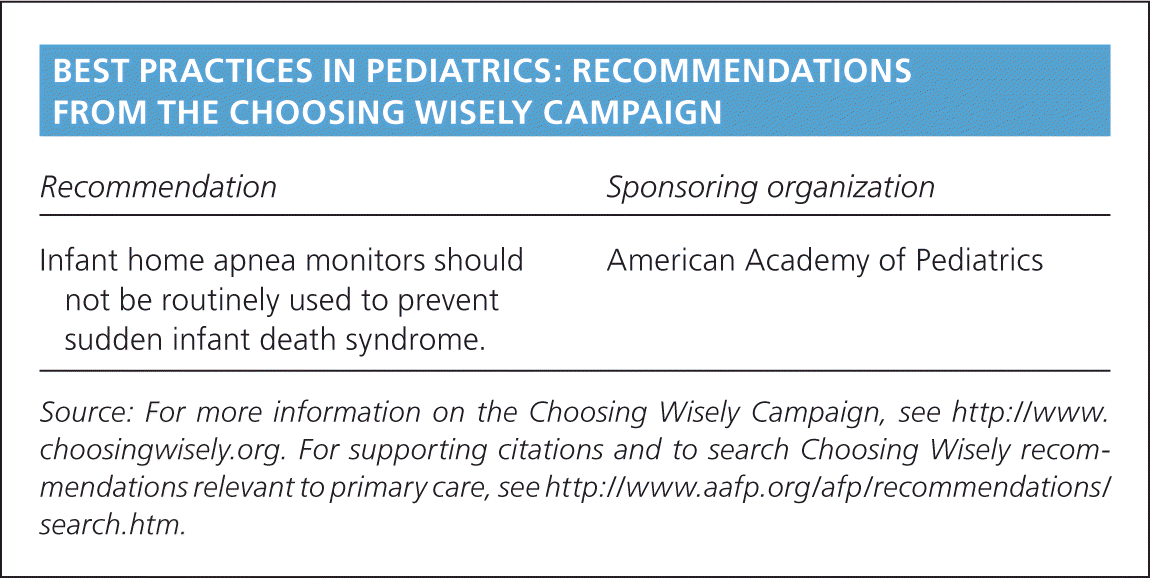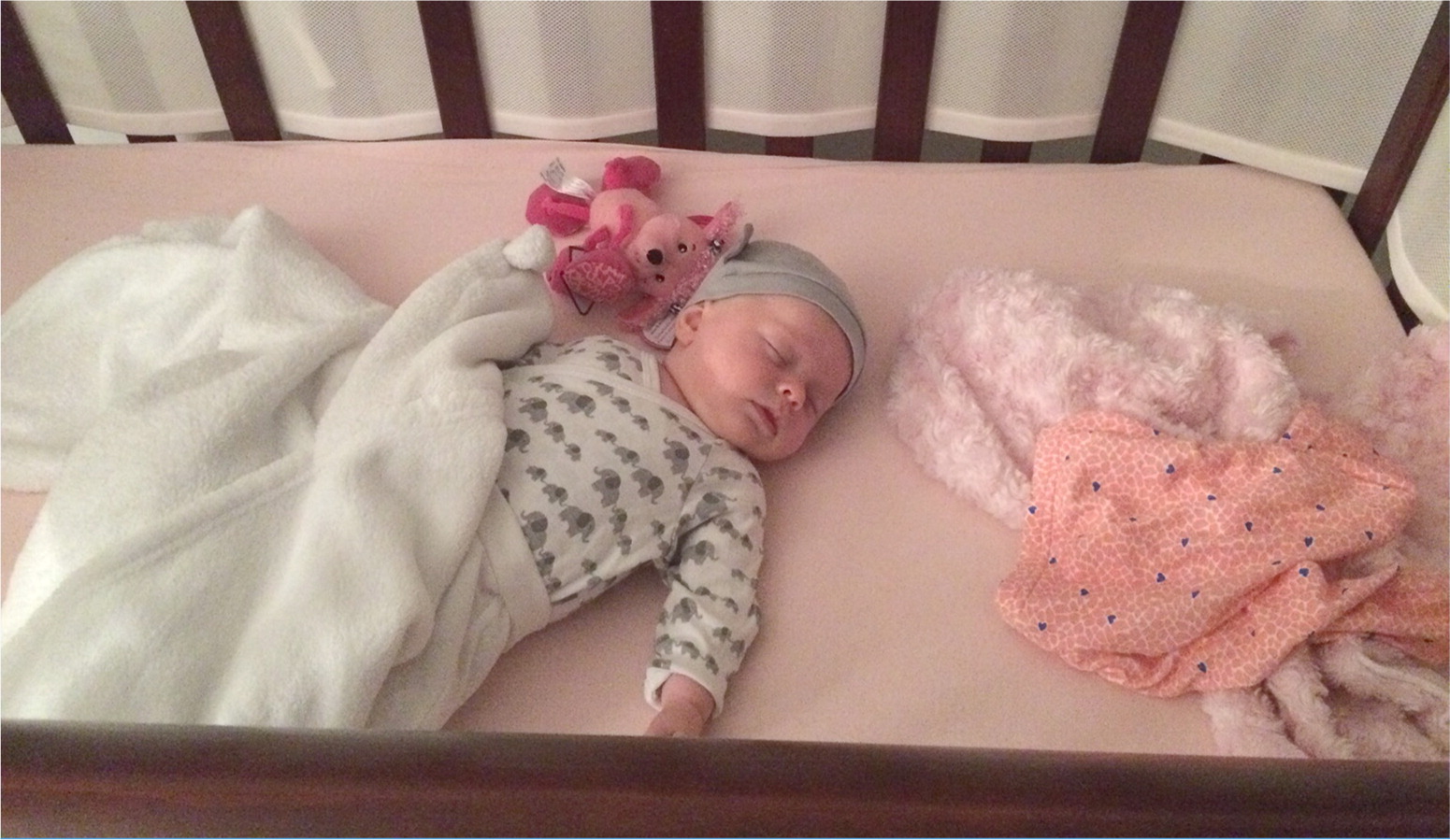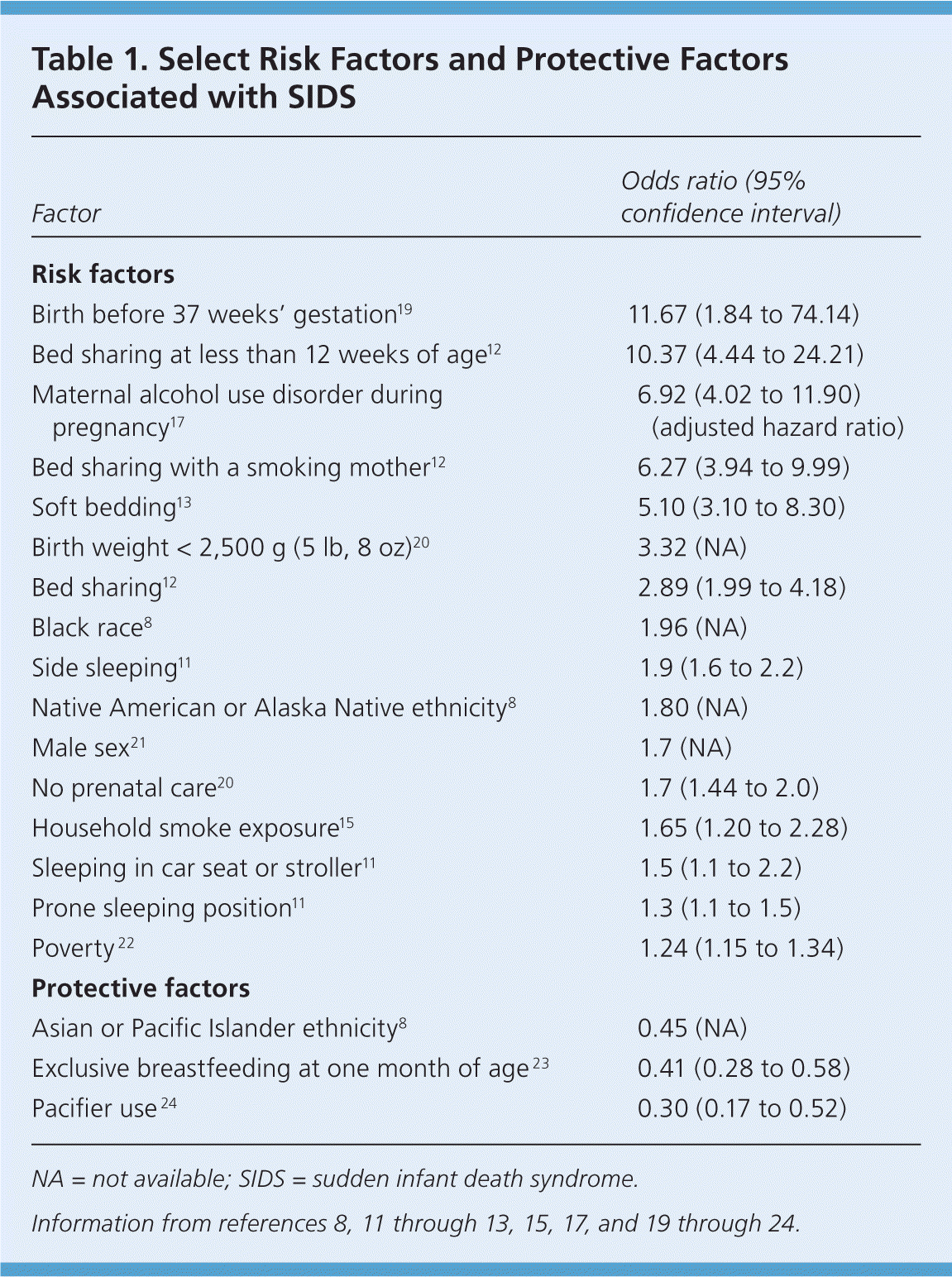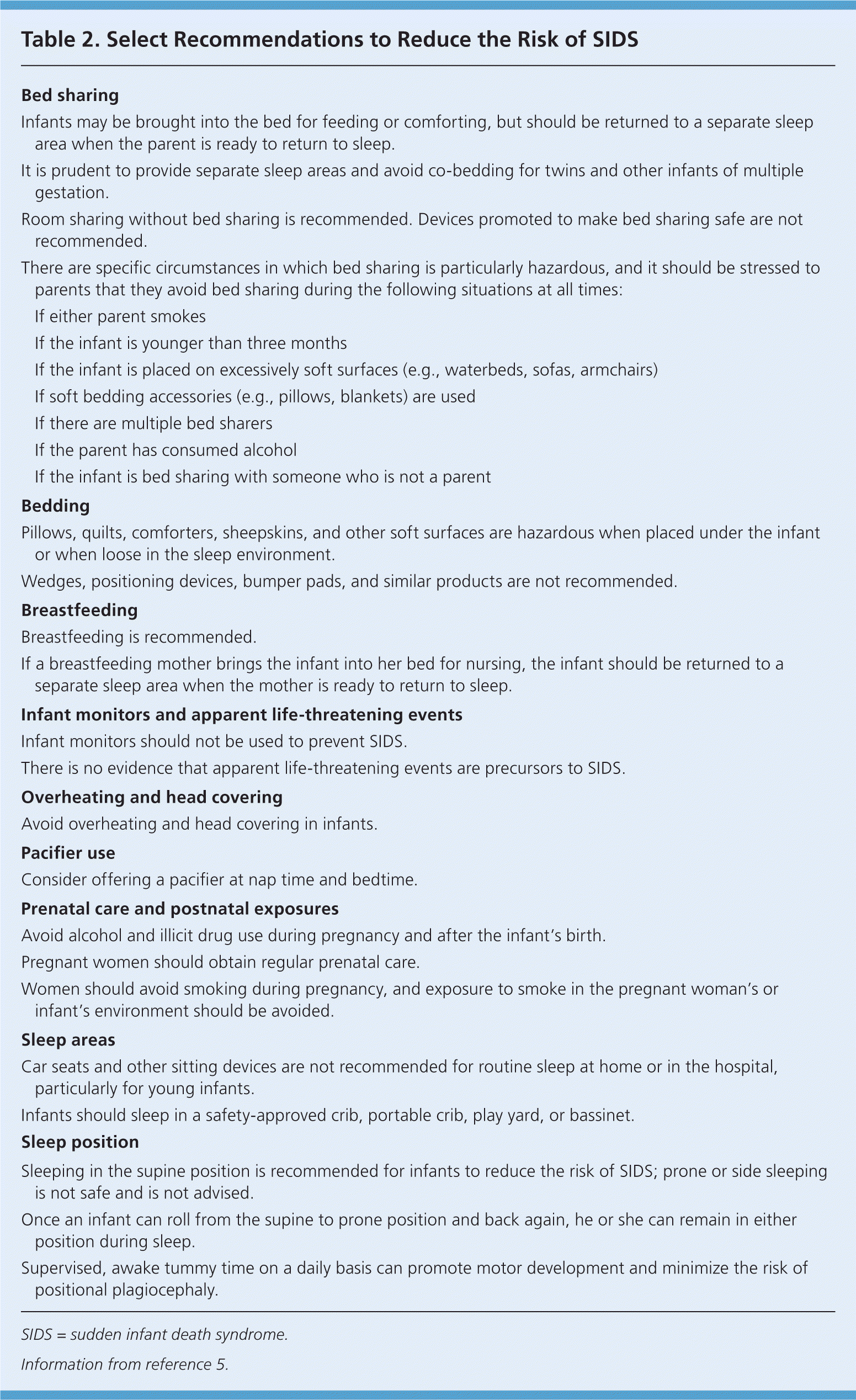
A more recent article on sudden infant death syndrome is available.
Am Fam Physician. 2015;91(11):778-783
Patient information: See related handout on sudden infant death syndrome, written by the authors of this article.
Author disclosure: No relevant financial affiliations.
Sudden infant death syndrome (SIDS) is the sudden unexpected death of a child younger than one year during sleep that cannot be explained after a postmortem evaluation including autopsy, a thorough history, and scene evaluation. The incidence of SIDS has decreased more than 50% in the past 20 years, largely as a result of the Back to Sleep campaign. The most important risk factors relate to the sleep environment. Prone and side sleeping positions are significantly more dangerous than the supine position. Bed sharing with a parent is strongly correlated with an increased risk of SIDS, especially in infants younger than 12 weeks. Apparent life-threatening events are not a risk factor for SIDS. Parents should place infants on their backs to sleep, should not share a bed, and should avoid exposing the infant to tobacco smoke. Other risk-reducing measures include using a firm crib mattress, breastfeeding, keeping vaccinations up to date, avoiding overheating due to overbundling, avoiding soft bedding, and considering the use of a pacifier during sleep once breastfeeding is established. One consequence of the Back to Sleep campaign is a significant increase in the incidence of occipital flattening. Infants who develop a flat spot should be placed with the head facing alternating directions each time he or she is put to bed. Supervised prone positioning while the infant is awake, avoiding excessive use of carriers, and upright positioning while awake are also recommended.
The most widely accepted definition of sudden infant death syndrome (SIDS) is the sudden unexpected death of a child younger than one year during sleep that cannot be explained after a postmortem evaluation including autopsy, a thorough history, and scene evaluation.1 The syndrome was first defined in 1969, and the definition has been refined by consensus through international conferences. A classification system has been developed that groups cases based on the presence of typical or atypical features and the completeness of the death investigation.2
| Clinical recommendation | Strength of recommendation | References | |
|---|---|---|---|
| To reduce the risk of sudden infant death syndrome, parents should: | |||
| Avoid sharing their bed with the infant, and avoid placing the infant in the prone or side sleeping position. | C | 11, 12 | |
| Avoid the use of car seats as a substitute for a crib or high chair. Car seats should be used only for transportation. | C | 5 | |
| Avoid soft bedding and overbundling the infant, especially when he or she is able to roll over. | C | 5, 14 | |
| Avoid tobacco use during and after pregnancy, and ensure that the infant is kept in a smoke-, alcohol-, and drug-free environment. | C | 5, 15, 17 | |
| Be encouraged to breastfeed. | C | 27 | |
| Consider offering a pacifier at nap time and bedtime. | C | 24, 28 | |

| Recommendation | Sponsoring organization |
|---|---|
| Infant home apnea monitors should not be routinely used to prevent sudden infant death syndrome. | American Academy of Pediatrics |
There are three international standards for the diagnosis of SIDS, and up to one-third of recently published SIDS studies do not use a standard definition of the disorder.3 The exact mechanism of SIDS is unknown. The triple-risk hypothesis states that it occurs when three factors overlap: an infant with inherent vulnerability who is within a critical developmental period and is exposed to a stressful sleep environment. Infants who die of SIDS appear to have abnormalities of cardiac and respiratory control within the brainstem, and it is thought that these abnormalities in combination with environmental stresses (e.g., sleep positioning, temperature, exposure to tobacco smoke) lead to a terminal cascade of hypoxia, bradycardia, apnea, and death.4,5
Epidemiology
The incidence of SIDS peaks between the second and fourth months of life, and SIDS is the most common cause of death between one month and one year of age.6 Deaths that do not occur during sleep are unlikely to be caused by SIDS.2 Increasing evidence that sleep position is associated with SIDS led the American Academy of Pediatrics (AAP) in 1992 to recommend against the prone position during sleep, and in 1994 the Back to Sleep campaign was introduced. Over the next decade, the incidence of SIDS in the United States decreased by 53%.5 Since then, the rate of SIDS has remained stable, while overall U.S. infant mortality rates have declined slightly. There is evidence that some of this decline is the result of increasing recognition of deaths due to asphyxiation or strangulation in sleep.5 Because of this, the AAP issued updated recommendations in 2011 that focus on safe sleep environments—not only SIDS.5
Each year in the United States, 4,500 deaths are categorized as sudden unexpected infant death.7 This includes deaths from SIDS or asphyxiation during sleep, and deaths in which there is insufficient information to categorize the cause. Approximately 2,500 of these deaths are caused by SIDS.6 There is a marked disparity in the incidence of SIDS among races and ethnicities. The risk is twice as high in Native American, Alaska Native, and black infants compared with non-Hispanic white infants.8 Asian, Pacific Islander, and Hispanic populations have the lowest rate in the United States.8 These differences correlate with different cultural practices in infant sleep position and location.9,10
Risk Factors
The most important risk factors for SIDS relate to the sleep environment (Figure 1). Sleep position is a strong risk factor for SIDS. The prone and side sleeping positions are significantly more dangerous than the supine position.11 They increase the risk of hypercapnia, hypoxia, and hyperthermia (due to overbundling) during sleep, and they more than double the risk of SIDS compared with the supine position. Bed sharing with a parent is also strongly correlated with an increased risk of SIDS, and is especially dangerous for infants younger than 12 weeks.12 Bed sharing is more common among poorer, less educated families and in the western and southern United States.10 Despite more than two decades of SIDS prevention efforts, the frequency of bed sharing has remained unchanged among white U.S. families and has increased among Hispanic and black families. Almost one-half of black mothers report sharing a bed with their infant.9,10 Compared with parents of other races, black parents are less likely to use supine sleep positioning and more likely to use nonstandard sleep locations. A study of black infants who died of SIDS found that 79% were in a sleeping location other than a crib, and 67% shared a bed with someone else.9

The use of car seats for sleeping also raises the risk of SIDS, as does the use of soft bedding materials. Many parents now use swaddle wraps and wearable blankets to reduce the risk of SIDS.13 Adverse events with these products are rare, provided that the infant is always placed in the supine position. The deaths that have occurred are mostly attributed to infants rolling into the prone position or incorrect application of the garment. Swaddling should be discouraged once an infant begins to attempt to roll over.14
Maternal mental illness and substance abuse are strong predictors of SIDS. Infants of a mother diagnosed with an alcohol use disorder during pregnancy have a sevenfold increased risk of SIDS, and it is estimated that maternal alcohol use is directly responsible for 16.4% of all SIDS deaths.17 Mental illness in either parent—and especially in both parents—is strongly associated with the risk of SIDS. The risk is doubled if there are both parental mental illness and addiction.18

| Factor | Odds ratio (95% confidence interval) |
|---|---|
| Risk factors | |
| Birth before 37 weeks' gestation19 | 11.67 (1.84 to 74.14) |
| Bed sharing at less than 12 weeks of age12 | 10.37 (4.44 to 24.21) |
| Maternal alcohol use disorder during pregnancy17 | 6.92 (4.02 to 11.90) (adjusted hazard ratio) |
| Bed sharing with a smoking mother12 | 6.27 (3.94 to 9.99) |
| Soft bedding13 | 5.10 (3.10 to 8.30) |
| Birth weight < 2,500 g (5 lb, 8 oz)20 | 3.32 (NA) |
| Bed sharing12 | 2.89 (1.99 to 4.18) |
| Black race8 | 1.96 (NA) |
| Side sleeping11 | 1.9 (1.6 to 2.2) |
| Native American or Alaska Native ethnicity8 | 1.80 (NA) |
| Male sex21 | 1.7 (NA) |
| No prenatal care20 | 1.7 (1.44 to 2.0) |
| Household smoke exposure15 | 1.65 (1.20 to 2.28) |
| Sleeping in car seat or stroller11 | 1.5 (1.1 to 2.2) |
| Prone sleeping position11 | 1.3 (1.1 to 1.5) |
| Poverty 22 | 1.24 (1.15 to 1.34) |
| Protective factors | |
| Asian or Pacific Islander ethnicity8 | 0.45 (NA) |
| Exclusive breastfeeding at one month of age 23 | 0.41 (0.28 to 0.58) |
| Pacifier use 24 | 0.30 (0.17 to 0.52) |
Apparent Life-Threatening Events
Except for the risk factors listed previously, there is no way to predict which infants will die of SIDS. Although alarming, apparent life-threatening events (ALTEs) are not related to SIDS and are not a risk factor for subsequent SIDS. ALTEs are characterized by apnea, choking, color change (cyanosis), and loss of motor tone. Although most ALTEs are benign, they can indicate severe injury or a manifestation of child abuse. A thorough history and physical examination, followed by targeted testing as needed, should be performed in children who experience an ALTE.25 The AAP recommends against the routine use of infant monitors to prevent SIDS because they have not been proven effective.5
Recommendations for SIDS Prevention
The AAP guidelines for reducing the risk of SIDS are outlined in Table 2.5 The recommendation for the supine sleeping position applies to all infants up to one year of age, or until the infant can roll from supine to prone and back again. Infants who spontaneously roll to the prone position do not need to be repositioned. Although prone positioning reduces gastroesophageal reflux, the risk of SIDS outweighs the risk of reflux.26 Infants should sleep in a crib that has all parts correctly installed. It should have a firm mattress that is covered with a fitted sheet. There should be no gaps between the mattress and the side of the crib, and parents should avoid soft pillows, blankets, toys, and bumper pads. The AAP states that the crib should ideally be placed next to the parents' bed.5 The infant should be dressed in one more layer of clothing than an adult finds comfortable, and garments or bedding that could cover the face should be avoided.5 Additional recommendations include regular prenatal care, avoidance of pre- and postnatal tobacco use, and avoidance of alcohol and drug use.

| Bed sharing | |
| Infants may be brought into the bed for feeding or comforting, but should be returned to a separate sleep area when the parent is ready to return to sleep. | |
| It is prudent to provide separate sleep areas and avoid co-bedding for twins and other infants of multiple gestation. | |
| Room sharing without bed sharing is recommended. Devices promoted to make bed sharing safe are not recommended. | |
| There are specific circumstances in which bed sharing is particularly hazardous, and it should be stressed to parents that they avoid bed sharing during the following situations at all times: | |
| If either parent smokes | |
| If the infant is younger than three months | |
| If the infant is placed on excessively soft surfaces (e.g., waterbeds, sofas, armchairs) | |
| If soft bedding accessories (e.g., pillows, blankets) are used | |
| If there are multiple bed sharers | |
| If the parent has consumed alcohol | |
| If the infant is bed sharing with someone who is not a parent | |
| Bedding | |
| Pillows, quilts, comforters, sheepskins, and other soft surfaces are hazardous when placed under the infant or when loose in the sleep environment. | |
| Wedges, positioning devices, bumper pads, and similar products are not recommended. | |
| Breastfeeding | |
| Breastfeeding is recommended. | |
| If a breastfeeding mother brings the infant into her bed for nursing, the infant should be returned to a separate sleep area when the mother is ready to return to sleep. | |
| Infant monitors and apparent life-threatening events | |
| Infant monitors should not be used to prevent SIDS. | |
| There is no evidence that apparent life-threatening events are precursors to SIDS. | |
| Overheating and head covering | |
| Avoid overheating and head covering in infants. | |
| Pacifier use | |
| Consider offering a pacifier at nap time and bedtime. | |
| Prenatal care and postnatal exposures | |
| Avoid alcohol and illicit drug use during pregnancy and after the infant's birth. | |
| Pregnant women should obtain regular prenatal care. | |
| Women should avoid smoking during pregnancy, and exposure to smoke in the pregnant woman's or infant's environment should be avoided. | |
| Sleep areas | |
| Car seats and other sitting devices are not recommended for routine sleep at home or in the hospital, particularly for young infants. | |
| Infants should sleep in a safety-approved crib, portable crib, play yard, or bassinet. | |
| Sleep position | |
| Sleeping in the supine position is recommended for infants to reduce the risk of SIDS; prone or side sleeping is not safe and is not advised. | |
| Once an infant can roll from the supine to prone position and back again, he or she can remain in either position during sleep. | |
| Supervised, awake tummy time on a daily basis can promote motor development and minimize the risk of positional plagiocephaly. | |
Physicians should promote breastfeeding and should consider recommending the use of a pacifier. Pacifier use is associated with a significantly lower risk of SIDS, although the reason for this risk reduction is unclear.24 Breastfeeding of any duration significantly reduces the risk of SIDS, and the effect is particularly robust with exclusive breast-feeding. A large meta-analysis of SIDS risk and breastfeeding found that infants who were exclusively breastfed had an odds ratio for SIDS of 0.27 (95% confidence interval, 0.24 to 0.31) compared with nonbreastfed infants.27 The decision to recommend pacifier use in breastfed infants is controversial. The AAP suggests postponing pacifier use until breastfeeding is well established, and recommends offering a pacifier for naps and at bedtime.28
Adverse Effects of Supine Sleep Positioning
An unforeseen consequence of the Back to Sleep campaign is a sharp increase in the incidence of occipital flattening. Deformational brachycephaly is symmetric flattening, whereas plagiocephaly refers to flattening of one side. Almost one in five infants in the United States has clinically evident posterior cranial flattening at four months of age. The incidence at two years of age falls to 3.3%. Infants with delayed motor development causing poor head control have a higher rate of flattening.5,29 Physicians should ask whether the infant has a preferential head position, because this may indicate congenital muscular torticollis. For infants who develop a flat spot, positioning with the head facing alternating directions each time he or she is placed in bed, supervised awake prone positioning (tummy time), avoidance of excessive use of carriers, and upright positioning while awake are recommended.1 Physical therapy may be indicated to address contractures of cervical muscles. Infants with mild flattening do not require treatment. Although treatment of more severe deformities with a helmet orthosis has been recommended,30 a recent randomized controlled trial showed no significant benefit for using an orthosis compared with no treatment.31
The Back to Sleep campaign has also resulted in statistically significant but clinically irrelevant delays in gross motor development. These differences disappear by 18 months of age. Regular awake prone positioning can prevent motor development delays and cranial flattening.32
note: This review updates a previous article on this topic by Adams, Good, and DeFranco.33
Data Sources: A PubMed search was completed using the search term sudden infant death (MeSH) and ALTE. Each abstract published in the past five years was read, and each article that provided new data was downloaded and reviewed. Also searched were http://www.guideline.gov, the American Academy of Pediatrics website (http://www.aap.org), the U.S. Preventive Services Task Force website (http://www.uspreventiveservicestaskforce.org) and the Cochrane database. Search dates: June 2014 through March 2015.
